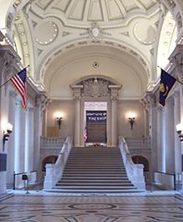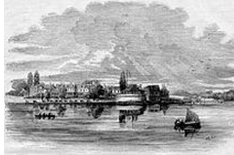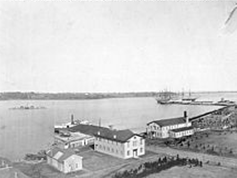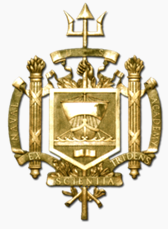
United States Naval Academy
USINFO | 2013-11-29 14:57
The United States Naval Academy (also known as USNA, Annapolis, or Navy) is a four-year coeducationalfederal service academy located in Annapolis, Maryland, United States. Established in 1845 under Secretary of the NavyGeorge Bancroft, it is the second-oldest of the United States' five service academies, and educates officers for commissioning primarily into the United States Navy and United States Marine Corps. The 338-acre (137 ha) campus is located on the former grounds of Fort Severn at the confluence of the Severn River and Chesapeake Bay, approximately 33 miles (53 km) east of Washington, D.C. and 26 miles (42 km) southeast of Baltimore, Maryland. The entire campus is a National Historic Landmark and home to many historic sites, buildings, and monuments.
Candidates for admission generally must both apply directly to the academy and receive a nomination, usually from a Member of Congress. Students are officers-in-training and are referred to as midshipmen. Tuition for midshipmen is fully funded by the Navy in exchange for an active duty service obligation upon graduation. Approximately, 1,300 "plebes" (an abbreviation of the Ancient Roman word plebian) enter the Academy each summer for the rigorous Plebe Summer, but only about 1,000 Midshipmen graduate. Graduates are usually commissioned as ensigns in the Navy or second lieutenants in the Marine Corps, but a small number can also be commissioned as officers in both the other US services, and the services of allied nations. The academic program grants a bachelor of science degree with a curriculum that grades midshipmen's performance upon a broad academic program, military leadership performance, and mandatory participation in competitive athletics. Midshipmen are required to adhere to the academy's Honor Concept.
Description

Rotunda steps leading to Memorial Hall
The United States Naval Academy's campus is located in Annapolis, Maryland, at the confluence of the Severn River and the Chesapeake Bay.In its most recent report, the 2012 edition of U.S. News & World Report ranked the US Naval Academy as the No. 1 Public Liberal Arts College in the nation, tied for first with the US Military Academy.[1] In the category of High School Counselor Rankings of National Liberal Arts Colleges, the Naval Academy is also tied for No. 1 with the US Military Academy and the US Air Force Academy.[2] It also holds the No. 5 spot with the US Air Force Academy for Best Undergraduate Engineering programs.[3] In the same year, Forbes ranked the US Naval Academy as No. 17 overall in nation in its report "America's Top Colleges 2011".[4]
Prospective candidates must be first nominated by a US congressman, senator, the Vice-President, or the President, or be the child of a Medal of Honor recipient. This nomination typically involves an interview with that specific nominating body and/or retired officers within the same jurisdiction. Candidates must also pass a physical fitness test and a thorough medical exam as part of the application process. In the 21st century, there have been about 1,200 students in each new class of plebes (freshmen).[5] The U.S. government pays for tuition, room and board. Midshipmen receive monthly pay of $990.00 as of 2012.[6] From this amount, pay is automatically deducted for the cost of uniforms, books, supplies, services, and other miscellaneous expenses. Midshipmen only receive a portion of their total pay in cash while the rest is released during "Firstie" (senior) year. Midshipmen Fourth-Class (plebes) to midshipmen second-class (juniors) receive $100, $200, $300, respectively. Midshipmen first-class receive the difference between pay and outstanding expenses.
Students at the naval academy are addressed as Midshipman, an official military rank and paygrade. As midshipmen are actually in the United States Navy, starting from the moment that they raise their hands and affirm the oath of office at the swearing-in ceremony, they are subject to the Uniform Code of Military Justice, of which USNA regulations are a part, as well as to all executive policies and orders formulated by the Department of the Navy. The same term comprises both males and females. Upon graduation, most naval academy midshipmen are commissioned as ensigns in the Navy or second lieutenants in the Marine Corps and serve a minimum of five years after their commissioning. If they are selected to serve as a pilot (aircraft), they will serve 8–11 years minimum from their date of winging, and if they are selected to serve as a naval flight officer they will serve 6–8 years. Foreign midshipmen are commissioned into the armed forces of their native countries. Since 1959, midshipmen have been able to "cross-commission," or request a commission in the Air Force or Army, provided they meet that service's eligibility standards. In 2004, the first of a handful of graduates was "cross-commissioned" into the Coast Guard. Every year, a small number of graduates do this- usually 3 or 4, and usually in a one-for-one "trade" with a similarly inclined cadet at one of the other service academies. At the beginning of their second-class year, midshipmen make this commitment, also known as signing their "2-for-7" which represents a commitment to finish two years at the academy and then an additional five years on active duty. Upon graduation, midshipmen are obligated to serve at minimum 5 years of service after graduation. Those selected for post-graduate education will continue concurrently with their commissioning obligation for officers in the US Navy and consecutively for officers in the US Marine Corps.
Midshipmen who entered the academy from civilian life and who resign or are separated from the academy in their first two years incur no military service obligation. Those who are separated – voluntarily or involuntarily – after that time are required to serve on active duty in an enlisted capacity, usually for two to four years. Alternatively, separated former midshipmen can reimburse the government for their educational expenses, though the sum is often in excess of $150,000. The decision whether to serve enlisted time or reimburse the government is at the discretion of the Secretary of the Navy. Midshipmen who entered the academy from the enlisted ranks return to their enlisted status to serve the remainder of their enlistment.
Other navy schools
There is no graduate school directly associated with the Naval Academy. The Navy operates the Naval Postgraduate School and the Naval War College separately. The Naval Academy Preparatory School (NAPS), in Newport, Rhode Island, is the official prep school for the Naval Academy. The Naval Academy Foundation provides post-graduate high school education for a year of preparatory school before entering the academy for a very limited number of applicants. There are several preparatory schools and junior colleges throughout the United States which host this program.
History

U.S. Naval Academy in 1853

Stereoscopic views of midshipman quarters and mess hall c. 1905
IdentityThe academy's Latinmotto is Ex Scientia Tridens, Which means "Through Knowledge, Sea Power." It appears on a design devised by the lawyer, writer, editor, encyclopedist and naval academy graduate (1867), Park Benjamin, Jr. It was adopted by the Navy Department in 1898 due to the efforts of another graduate (also 1867) and collaborator, Jacob W. Miller. Benjamin states:[7]
"The seal or coat-of-arms of the Naval Academy has for its crest a hand grasping a trident, below which is a shield bearing an ancient galley coming into action, bows on, and below that an open book, indicative of education, and finally bears the motto, 'Ex Scientia Tridens' (From knowledge, sea power)."
The trident, emblem of the Roman godNeptune, represents seapower.
Early years
The institution was founded as the Naval School in 1845 by Secretary of the NavyGeorge Bancroft. The campus was established at Annapolis on the grounds of the former U.S. Army post Fort Severn. The school opened on 10 October with 50 midshipmen students and seven professors. The decision to establish an academy on land may have been in part a result of the Somers Affair, an alleged mutiny involving the Secretary of War's son that resulted in his execution at sea. CommodoreMatthew Perry had a considerable interest in naval education, supporting an apprentice system to train new seamen, and helped establish the curriculum for the United States Naval Academy. He was also a vocal proponent of modernization of the navy.
Originally a course of study for five years was prescribed. Only the first and last were spent at the school with the other three being passed at sea. The present name was adopted when the school was reorganized in 1850 and placed under the supervision of the chief of the Bureau of Ordnance and Hydrography. Under the immediate charge of the superintendent, the course of study was extended to seven years with the first two and the last two to be spent at the school and the intervening three years at sea. The four years of study were made consecutive in 1851 and practice cruises were substituted for the three consecutive years at sea. The first class of naval academy students graduated on 10 June 1854.
In 1860, the Tripoli Monument was moved to the academy grounds. Later that year in August, the model of the USS Somers experiment was resurrected when the USS Constitution, now 60 years old, was pulled out of ordinary and refurbished as a school ship for the fourth-class midshipmen. She was anchored at the yard, and the plebes lived on board the ship to immediately introduce them to shipboard life and experiences.[8]
The American Civil War
The Civil War was disruptive to the naval academy. Southern sympathy ran high in Maryland. Although riots broke out, Maryland did not declare secession. The United States government planned to move the school, when the sudden outbreak of hostilities forced a quick departure. Almost immediately the three upper classes were detached and ordered to sea, and the remaining elements of the academy were transported to Fort Adams, Newport, Rhode Island by the USS Constitution in April 1861 and setup in temporary facilities and opened there in May.[9] The Annapolis campus, meanwhile, was turned into a United States Army Hospital.[10]

The United States Navy was stressed by the situation as 24% of its officers resigned and joined the Confederate States Navy, including 95 graduates and 59 midshipmen,[8] as well as many key leaders involved with the founding and establishment of USNA. The first Superintendent, Admiral Franklin Buchanan, joined the Confederate States Navy as its first and primary admiral. Captain Sidney Smith Lee, the second commandant of midshipmen,[11] and older brother of Robert E. Lee, left Federal service in 1861 for the Confederate States Navy. Lieutenant William Harwar Parker,CSN, class of 1848, and instructor at USNA, joined the Virginia State Navy, and then went on to become the superintendent of the Confederate States Naval Academy. Lieutenant Charles “Savez” Read may have been "anchor man" (graduated last) in the class of 1860, but his later service to the Confederate States Navy included defending New Orleans, service on CSS Arkansas and CSS Florida, and command of a series of captured Union ships that culminated in seizing the US Revenue Cutter Caleb Cushing in Portland, Maine. Lieutenant James Iredell Waddell, CSN, a former instructor at the US Naval Academy commanded the CSS Shenandoah. The first superintendent of the United States Naval Observatory,], advocate[12] of the creation of the United States Naval Academy, after whom Maury Hall is named, similarly served in the Confederate States Navy.
Share this page




















